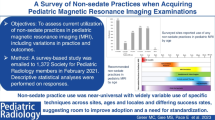Abstract
Background
There are few data describing practice patterns related to the use of sedation/anesthesia for diagnostic imaging in pediatric radiology departments.
Objective
To understand current practice patterns related to imaging with sedation/anesthesia in pediatric radiology departments based on a survey of the Society of Chiefs of Radiology at Children’s Hospitals (SCORCH) in conjunction with the American College of Radiology’s Pediatric Imaging Sedation and Anesthesia Committee.
Materials and methods
A multi-question survey related to imaging with sedation/anesthesia in pediatric radiology departments was distributed to SCORCH member institutions in January 2019. A single reminder email was sent. Descriptive statistical analyses were performed.
Results
Of the 84 pediatric radiology departments, 23 (27%) completed the survey. Fifty-seven percent of the respondents self-identified as academic/university-affiliated and 13% as a division/section in an adult radiology department. Imaging sedation (excluding general anesthesia) is commonly performed by pediatric anesthesiologists (76%) and intensive care unit physicians (intensivists, 48%); only 14% of departments expect their pediatric radiologists to supervise imaging sedation. Ninety-six percent of departments use child life specialists for patient preparation. Seventy percent of departments have preparatory resources available on a website, including simulation videos (26%) and audio clips (17%). Nearly half (48%) of the departments have a mock scanner to aid in patient preparation. Imaging sedation/anesthesia is most often scheduled at the request of ordering clinicians (65%), while 57% of departments allow schedulers to place patients into imaging sedation/anesthesia slots based on specified criteria.
Conclusion
Imaging sedation/anesthesia practice patterns vary among pediatric radiology departments, and understanding current approaches can help with standardization and practice improvement.
Similar content being viewed by others
References
Frush DP, Bisset GS 3rd, Hall SC (1996) Pediatric sedation in radiology: the practice of safe sleep. AJR Am J Roentgenol 167:1381–1387
Slovis TL (2011) Sedation and anesthesia issues in pediatric imaging. Pediatr Radiol 41(Suppl 2):514–516
Cravero JP, Beach ML, Blike GT et al (2009) The incidence and nature of adverse events during pediatric sedation/anesthesia with propofol for procedures outside the operating room: a report from the Pediatric Sedation Research Consortium. Anesth Analg 108:795–8044
Rudder BS, Easley SJ, Robinson AL et al (2019) Effects of an MRI Try Without program on patient access. Pediatr Radiol 49:1712–1717
Jaimes C, Gee MS (2016) Strategies to minimize sedation in pediatric body magnetic resonance imaging. Pediatr Radiol 46:916–927
McGee K (2003) The role of a child life specialist in a pediatric radiology department. Pediatr Radiol 33:467–474
Tyson ME, Bohl DD, Blickman JG (2014) A randomized controlled trial: child life services in pediatric imaging. Pediatr Radiol 44:1426–1432
Szeszak S, Man R, Love A et al (2016) Animated educational video to prepare children for MRI without sedation: evaluation of the appeal and value. Pediatr Radiol 46:1744–1750
Brown RKJ, Petty S, O'Malley S et al (2018) Virtual reality tool simulates MRI experience. Tomography 4:95–98
Morel B, Andersson F, Samalbide M et al (2020) Impact on child and parent anxiety level of a teddy bear-scale mock magnetic resonance scanner. Pediatr Radiol 50:116–120
Barnea-Goraly N, Weinzimer SA, Ruedy KJ et al (2014) High success rates of sedation-free brain MRI scanning in young children using simple subject preparation protocols with and without a commercial mock scanner — the Diabetes Research in Children Network (DirecNet) experience. Pediatr Radiol 44:181–186
Carter AJ, Greer M-LC, Gray SE, Ware RS (2010) Mock MRI: reducing the need for anaesthesia in children. Pediatr Radiol 40:1368–1374
de Bie HMA, Boersma M, Wattjes MP et al (2010) Preparing children with a mock scanner training protocol results in high quality structural and functional MRI scans. Eur J Pediatr 169:1079–1085
Edwards AD, Arthurs OJ (2011) Paediatric MRI under sedation: is it necessary? What is the evidence for the alternatives? Pediatr Radiol 41:1353–1364
Vanderby SA, Babyn PS, Carter MW et al (2010) Effect of anesthesia and sedation on pediatric MR imaging patient flow. Radiology 256:229–237
Wilder RT, Flick RP, Sprung J et al (2009) Early exposure to anesthesia and learning disabilities in a population-based birth cohort. Anesthesiology 110:796–804
Creeley C, Dikranian K, Dissen G et al (2013) Propofol-induced apoptosis of neurones and oligodendrocytes in fetal and neonatal rhesus macaque brain. Br J Anaesth 110(Suppl 1):i29–i38
Callahan MJ, MacDougall RD, Bixby SD et al (2018) Ionizing radiation from computed tomography versus anesthesia for magnetic resonance imaging in infants and children: patient safety considerations. Pediatr Radiol 48:21–30
Barton K, Nickerson JP, Higgins T, Williams RK (2018) Pediatric anesthesia and neurotoxicity: what the radiologist needs to know. Pediatr Radiol 48:31–36
Acknowledgments
We would like to thank Dr. Richard Barth, ACR Pediatric Commission Chair, and the Society of Chiefs of Radiology at Children’s Hospitals (SCORCH) their help with this study.
Author information
Authors and Affiliations
Corresponding author
Ethics declarations
Conflicts of interest
None
Additional information
Publisher’s note
Springer Nature remains neutral with regard to jurisdictional claims in published maps and institutional affiliations.
Appendix
Appendix
Rights and permissions
About this article
Cite this article
Dillman, J.R., Gee, M.S., Ward, C.G. et al. Imaging sedation and anesthesia practice patterns in pediatric radiology departments — a survey of the Society of Chiefs of Radiology at Children’s Hospitals (SCORCH). Pediatr Radiol 51, 1497–1502 (2021). https://doi.org/10.1007/s00247-021-04996-y
Received:
Revised:
Accepted:
Published:
Issue Date:
DOI: https://doi.org/10.1007/s00247-021-04996-y




